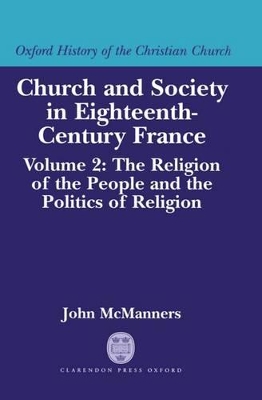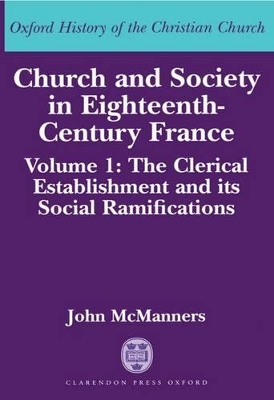Oxford History of the Christian Church
3 total works
This second volume begins with a Section on the religion of the people. The clergy offered the liturgical services, sermons, evangelistic missions, and the offices sanctifying birth, marriage, and death; distinctions are made between what they intended and how their ministrations were popularly interpreted and incorporated into the social order. Statistical soundings concerning the extent of religious practice and the degree of conviction involved are evaluated. Further chapters deal with processions, pilgrimages, and popular practices and superstitions, with hermits and confraternities, with the impact of reading the Bible and other edifying literature in an age of increasing literacy. Finally comes a view of the twilight world of magic and sorcery. Throughout this Section the comments of theologians and thinkers of the Enlightenment are recorded, whether in coincidence or contradiction. The next section deals with the efficacy of the confessional and the role of the casuistry of the Church in attempting to mould sexual mores, business practices, and in the world of the theatre. In the next two Sections, the role of religious issues in political affairs is detailed.
An overview of the Jansenist quarrel and of the activities of the Jesuits brings in the story of the struggle between Crown and Parlement, while an extended portrayal of the life of the Protestant and Jewish communities leads to the history of the debate on toleration, involving the Gallican Church in political interventions and controversy. Throughout the two volumes the rising forces of anticlericalism and the tensions within the ecclesiastical establishment have been recorded, and these themes come to their climax in a final section on the role played by churchmen in the coming of the Revolution.
An overview of the Jansenist quarrel and of the activities of the Jesuits brings in the story of the struggle between Crown and Parlement, while an extended portrayal of the life of the Protestant and Jewish communities leads to the history of the debate on toleration, involving the Gallican Church in political interventions and controversy. Throughout the two volumes the rising forces of anticlericalism and the tensions within the ecclesiastical establishment have been recorded, and these themes come to their climax in a final section on the role played by churchmen in the coming of the Revolution.
This second volume begins with a Section on the religion of the people. The clergy offered the liturgical services, sermons, evangelistic missions, and the offices sanctifying birth, marriage, and death; distinctions are made between what they intended and how their ministrations were popularly interpreted and incorporated into the social order. Statistical soundings concerning the extent of religious practice and the degree of conviction involved are evaluated.
Further chapters deal with processions, pilgrimages, and popular practices and superstitions, with hermits and confraternities, with the impact of reading the Bible and other edifying literature in an age of increasing literacy. Finally comes a view of the twilight world of magic and sorcery.
Throughout this Section the comments of theologians and thinkers of the Enlightenment are recorded, whether in coincidence or contradiction.
The next section deals with the efficacy of the confessional and the role of the casuistry of the Church in attempting to mould sexual mores, business practices, and in the world of the theatre.
In the next two Sections, the role of religious issues in political affairs is detailed. An overview of the Jansenist quarrel and of the activities of the Jesuits brings in the story of the struggle between Crown and Parlement, while an extended portrayal of the life of the Protestant and Jewish communities leads to the history of the debate on toleration, involving the Gallican Church in political interventions and controversy.
Throughout the two volumes the rising forces of anticlericalism and the tensions within the ecclesiastical establishment have been recorded, and these themes come to their climax in a final section on the role played by churchmen in the coming of the Revolution.
Further chapters deal with processions, pilgrimages, and popular practices and superstitions, with hermits and confraternities, with the impact of reading the Bible and other edifying literature in an age of increasing literacy. Finally comes a view of the twilight world of magic and sorcery.
Throughout this Section the comments of theologians and thinkers of the Enlightenment are recorded, whether in coincidence or contradiction.
The next section deals with the efficacy of the confessional and the role of the casuistry of the Church in attempting to mould sexual mores, business practices, and in the world of the theatre.
In the next two Sections, the role of religious issues in political affairs is detailed. An overview of the Jansenist quarrel and of the activities of the Jesuits brings in the story of the struggle between Crown and Parlement, while an extended portrayal of the life of the Protestant and Jewish communities leads to the history of the debate on toleration, involving the Gallican Church in political interventions and controversy.
Throughout the two volumes the rising forces of anticlericalism and the tensions within the ecclesiastical establishment have been recorded, and these themes come to their climax in a final section on the role played by churchmen in the coming of the Revolution.
This, the first volume, begins with a Section on Church and State, the theology and political theory justifying their alliance, the wealth of the Clergy and their Assemblies voting taxation, their role in the official life of the nation, from the Court at Versailles to army barracks, warships, and prisons. Then comes a presentation of the complex structure of dioceses and parishes, and the vast variety of monastic institutions (where the enjoyment of misapplied
wealth contrasted with the austere dedication which ensured the education of the children and the care of the sick throughout the land). There is an evocation of the life-style of the clergy from the palaces of the aristocratic bishops and the cathedral closes of comfortable canons to the humblest
tumbledown nunnery, with a gallery of portraits analysing clerical motives and vocations. A multitude of lay folk come onto the scene, aristocrats battening on monastic revenues, lawyers threading the labyrinth of benefice law, estate managers, musicians, vergers and officials of every kind; many families' whole way of existence was postulated on the assumption of the availability of ecclesiastical offices for their children—the differential privileges of the classes in the hierarchy of
society being reflected in an institution devoted to spiritual and unworldly ends.
wealth contrasted with the austere dedication which ensured the education of the children and the care of the sick throughout the land). There is an evocation of the life-style of the clergy from the palaces of the aristocratic bishops and the cathedral closes of comfortable canons to the humblest
tumbledown nunnery, with a gallery of portraits analysing clerical motives and vocations. A multitude of lay folk come onto the scene, aristocrats battening on monastic revenues, lawyers threading the labyrinth of benefice law, estate managers, musicians, vergers and officials of every kind; many families' whole way of existence was postulated on the assumption of the availability of ecclesiastical offices for their children—the differential privileges of the classes in the hierarchy of
society being reflected in an institution devoted to spiritual and unworldly ends.


